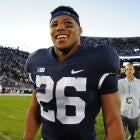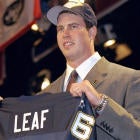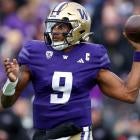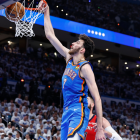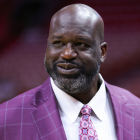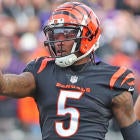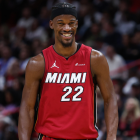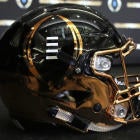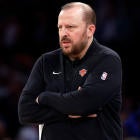Saquon Barkley has deservedly received massive amounts of fanfare during the 2018 draft process after an illustrious career at Penn State. He's destined to be picked in the top 10 next week.
How does he stack up to the four other backs who've been picked inside the top 10 over the past three years and where could he land in the 2018 NFL Draft?
Here's my ranking of Barkley, Todd Gurley, Ezekiel Elliott, Leonard Fournette, and Christian McCaffrey as prospects when they were entering the NFL.
Ed. Note: Will Brinson had Lance Zeirlein of NFL Media on the most recent edition of the now-daily Pick Six Podcast to talk about this very subject. Subscribe: via iTunes | via Stitcher | via TuneIn or listen to the full show below for 30 minutes of dialed-in football talk every day.
5. Leonard Fournette
Fournette was a solid running-back prospect. But based on the immense hype he received during the pre-draft process last year, he was overrated. The former top high-school recruit -- which factored into how favorably he was widely viewed -- is a train at 240 pounds with 4.51 speed. He's the epitome of a "runway back," as he needs a clear-cut lane to reach top speed, and is not very elusive. Being fast undoubtedly helps as a runner in the NFL, but the best are those who can make defenders miss near the line of scrimmage and down the field. Fournette was not that type of prospect. Good luck tackling him after he breaks through the secondary on a well-blocked run though. His rookie season was a perfect example of the type of back he can be in the NFL. Last year's No. 4 overall pick had a 75-yard run and a league-high 90-yard run for a touchdown. While those runs were clearly important, if the 75-yarder is taken away, he averaged 3.61 yards per carry in 2017. Those two splash plays accounted for 15.8 percent of his regular-season rushing yards. The offensive line needs to improve in Jacksonville to get the most out of Fournette's awesome size and speed combination.
4. Todd Gurley
Gurley was a more advanced version of Fournette, another big back with an almost unfair combination of size and speed. A knee injury in his final season at Georgia kept him from running the 40 at the combine or even at his pro day, yet at 6-foot and 222 pounds, I wouldn't have been surprised if he ran in the low 4.5s or even high 4.4s. As a prospect, Gurley had slightly more wiggle than Fournette, although agility wasn't his forte. And for as much power as he packed behind his pads, he often would seek out contact, which makes for a tremendous highlight reel but isn't the smartest running style for the sake of longevity at the NFL level. His pro career got off to a ridiculous start, then he fizzled in his next 24 games when he averaged just 3.35 yards per carry. Last season, he was a legitimate Offensive Player of the Year candidate. With better blocking -- which always helps -- Gurley averaged 4.87 yards per carry from Week 2 to the end of the regular season and caught 59 passes for 732 yards with six receiving scores. The receiving talent around Gurley kept defenses honest much more than they had been during his first two seasons.
3. Christian McCaffrey
McCaffrey's vision, lateral quickness, and make-you-miss capabilities made him a fun running-back prospect. His feet and his eyes were frequently in sync at Stanford, as he'd see a cutback lane forming, put his foot in the ground, and quickly explode through the hole the moment it opened to hit the big gainer. At the college level he had breakaway speed too and was a menace in the screen game. Like Fournette and Gurley, his rookie season in the NFL wasn't spectacular, and the offensive line didn't do him many favors. Also, like his top-10 pick contemporaries, the offense he found himself in wasn't very imposing through the air, so McCaffrey dealt with many loaded boxes. From November through the rest of the regular season in 2017, McCaffrey averaged a hefty 4.68 yards per carry and caught 31 passes for 273 yards with three receiving touchdowns. On the year though, because of an extremely rough start, he averaged just 3.72 yards per rush but did amass 80 catches for 651 yards and five receiving scores. With Carolina likely to expand its offense to a more balanced attack in 2018, he should take the next step as a three-down back.
(Note: Brutal off-field concerns aside, this is where Joe Mixon would've been placed had he gone inside the top 10 last year. His film was mesmerizing. He demonstrated a rare blend of size, springy athleticism, vision, balance, and blazing speed. His jump cuts at 228 pounds were out of this world, and he proved to be a dynamic pass-catcher during his career at Oklahoma. He was extremely close to Elliott as a prospect, and to me, at his best in college, Mixon was more dynamic. His 263-yard masterpiece against Texas Tech was the best running-back prospect film I've ever watched. With the Bengals likely to retool their offensive line in the draft, he should be in for a huge jump in 2018.)
1b. Ezekiel Elliott
Until this year, Elliott was the most complete running back prospect I've ever scouted. His film was almost boring to watch. He seemingly always found daylight in tight quarters on inside runs, had elite change-of-direction ability for his size, quality long speed, and plenty of power to either gallop through arm tackles or finish plays falling forward. He was a brick wall in pass-protection too and undoubtedly held his own on screen plays. Behind arguably the league's best offensive line as a rookie, he led the league in rushing and showed no signs of slowing down later in the season despite an enormous workload. From Thanksgiving to the end of the regular season, he averaged a whopping 5.34 yards per carry with six rushing touchdowns. Off-field issues made last year somewhat of a nightmare for Elliott, and his yards-per-attempt average dipped to 4.06 after averaging 5.06 yards per carry in his debut campaign. The blocking regressed as did the Cowboys passing game, proving that even the most talented running backs can't do it on their own.
1a. Saquon Barkley
Ranking Elliott against Barkley wasn't easy. They're similarly built, comparably talented runners. Here's the difference between them. Elliott was a better pass blocker and was more refined between the tackles. He got everything that was blocked for him and then some. Barkley has a tendency to bounce runs outside as he gets to the second level when staying North-South or even if cutting back appears to be the better option. That method typically worked in college because Barkley is an athletic freak. In the NFL, it could give him some problems. However, Barkley's more explosive than Elliott and more likely to hit a 75-yard touchdown when the last 60 yards depend on nothing but pure speed. Also, Barkley's a more reliable receiver and is better in space on screen plays and short routes out of the backfield. The juice he has in his legs and his pass-catching skill puts him ever so slightly ahead of Elliott, although the two are absolutely franchise cornerstone running backs.












